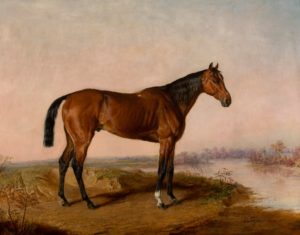
It’s Travers Week, and we look forward to crowning the next three-year-old champion of the mile-and-a-quarter “Mid-summer Derby” this Saturday at Saratoga Race Track. The race has amassed 150 winners to date, its earliest titleholder being a colt named Kentucky in its inaugural running on August 2, 1864. This first edition of the race was contested in heats at a distance of one and three-quarter miles over the Saratoga Racing Association’s new course.
The Travers winner was one of Lexington’s three great sons foaled in 1861, the other two racers being Asteroid and Norfolk, all of whom were the produce of mares by Glencoe. Kentucky, out of John M. Clay’s Ashland Stud broodmare Magnolia, seized 21 wins over his career of 22 starts, with his only loss occurring to the unconquerable Norfolk in his second race, the 1864 Jersey Derby. Recognized by the National Museum of Racing for his achievements, Kentucky was inducted into the Hall of Fame in 1983.
The preeminent antebellum equine artist Edward Troye preserved Kentucky’s likeness for posterity in 1866 as a result of commissions by his owner, Leonard Jerome. Ownership of Kentucky had changed hands that year when the partnership of William R. Travers, John Hunter and George Osgood sold him to Jerome for the remarkable sum of $40,000 following the horse’s victory in the Inauguration Stakes, a race of four-mile heats at Jerome Park.

Jerome commissioned four paintings, and Troye successfully captured the soul of this gallant thoroughbred in various representations. One features Kentucky in his stall, “listening for the foot fall that announces the approach of his groom,” described Sanders Bruce of Turf, Field and Farm. Two portraits position the horse outside, standing near the Passaic River, one with his head pointed to the left, and the other pointed to the right.
In the fourth portrait, Kentucky is represented at Jerome Park, with the grandstand in view behind him to the right; to the left is Leonard Jerome in his private road coach, joined by his family as well as the three members of Kentucky’s former syndicate—Hunter, Osgood and Travers. Bruce of Turf, Field and Farm remarked about this painting:
If it ever fades from the canvas, it will be for the reason that so much of the real spirit of the immortal racer is embodied in it, that it will grow tired of its fetters, burst the trammels, and, with an eagle bound, join with the planets in a grand and never ending race around the sun.
One of the two outdoor portraits—with Kentucky’s head pointed left—provided the basis for the lot that was sold for $17,250 during the 2014 Sporting Art Auction at the Keeneland Sales Pavilion (see 2014 catalogue online here—portrait of Kentucky is #16, page 28). The Sporting Art Auction was launched in 2013 through a partnership between Keeneland and Lexington’s Cross Gate Gallery, which specializes in equine-related art and is a leading source of the world’s sporting art.
In Troye’s obituary in 1874, his friend A. Keene Richards wrote that the artist was “The Master of a school (of animal painting) which he had made himself, and which seemed destined to die with him, for the tricks of the trade of the Photographer have already encroached upon his work.” Photography may have usurped the school of American equine portraiture, yet we are grateful that the works of the Master have survived.
Read more about Edward Troye in the Times’ contribution to American Racehorse magazine, “Edward Troye: America’s Equine Artist,” here.
Leave a Reply
You must be logged in to post a comment.